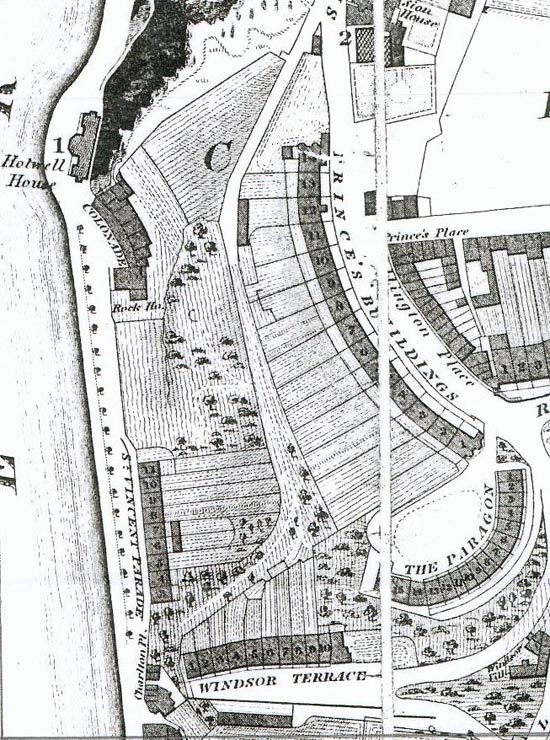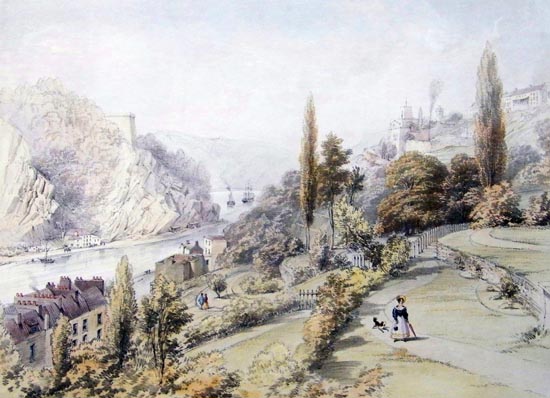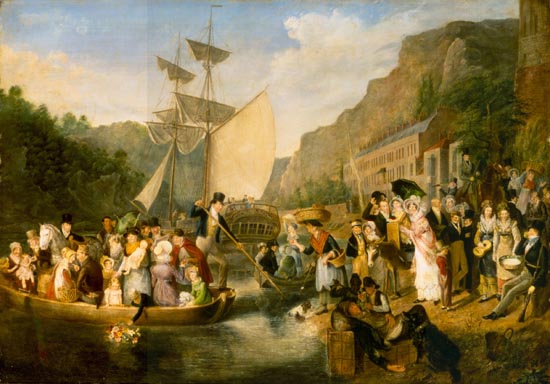
HOME





HOME
|

|

|

|

|
|
P R O F I L E |
||||
|
 CLIFTON HOTWELL SPA PAST AND PRESENTPRINCEíS LANE.  
Princeís Lane might have been one of the original ancient tracks from Hotwells to Clifton, in the Avon Gorge. The site later formed part of Rownham Woods which comprised some thirteen acres. By the end of the 18th century and the early 19th century, the Society of Merchant Venturers granted to Samuel Powell a building lease, for The Colonnade (1786), St. Vincentís Parade (1790), Princeís Buildings (1796), and Rock House. Rock House is generally considered to be the oldest surviving building associated with the Hotwell (see Chapter 20). John Power conveyed part of the woods to William Watts for the construction of Windsor Terrace (1790-1808). The above development of the Avon Gorge cleared Rownham Woods, and created a triangle of land on the north side of the gorge, that became enclosed as a result, by Mansion Houses, whose garden walls all entered on to Princeís Lane. The Lane started at the bottom of the gorge, at the base rock of Windsor Terrace, and came out half way up Sion Hill. It is clearly shown as a public footpath, dotted with trees, in Ashmeadís map of 1828. Some of the gardens were quite steep in parts and therefore, had to be terraced, because of the gradient of the gorge. 
Above: Ashmeadís map of 1828 showing Princeís Lane, which was important to the topography of the area during the life of the Spa. Showing the 1822 Hotwell House (see Chapter 19), by Henry Seward, designed in the Etruscan style, next to The Colonnade, Rock House and St. Vincentís Parade. Above, are Princeís Buildings and Windsor Terrace. 
Above: Walking in Clifton, painted in watercolour between 1842-1861, by T. Sopwith. This Lithograph print was produced by J. R. Jobbins. Princeís Lane was a wooded, well-used-and-enjoyed, public footpath in Clifton. In the picture above, it stretched diagonally across from bottom left to middle right. In the top right hand corner is Princeís Buildings, in the bottom left is St. Vincentís Parade. The figure with dog in the foreground is walking up the path that linked Princeís Lane to the back of Windsor Terrace and The Paragon, at the top of the Avon Gorge. The figures in the background are winding their way through a wooded area that branched off Princeís Lane to the back gardens of Rock House and The Colonnade, at the bottom of the Avon Gorge. These tracks are marked out by faint dotted lines in Ashmeadís map of Princeís Lane of 1828 (see Chapter 15). The bottom of Princeís Lane came out between the base rock of Windsor Terrace and St. Vincentís Parade, the starting point of the fashionable tree-lined Promenade to Hotwell House. Since World War II, much of this area experienced secondary forest growth, which has become established, and unfortunately most of the garden gates and walls to The Colonnade, Rock House, St. Vincentís Parade and Windsor Terrace are in need of repair and in parts, ruinous. In the 1970s, access to Princeís Lane from Hotwell Road was walled off, and a gate was put in the wall on Hinton Lane, which was locked and prevented people from using it. Allotments were placed behind the wall. Unfortunately, since then a lot of debris has accumulated at the bottom of Princeís Lane, so high in parts that it is the height of the garden walls, which have crumbled. Nevertheless, the garden walls and gates to Princeís Buildings are in a much better condition, where residents have made efforts to repair and maintain them which, of course, helps to conserve the Lane itself. 
Above: Rownham Ferry, by Rolinda Sharples, oil on canvas 1820-22. This beautiful painting above (now lost), is a record of people coming down from Clifton and queuing up Princeís Lane, waiting for Rownham Ferry, with the backdrop of St. Vincentís Rocks and St. Vincentís Parade, carrying with them musical instruments and baskets of food. A favourite amusement was sailing down river, often accompanied by another boat with musicians on board whose music, when echoed and re-echoed by the rocks, has a most delightful effect, not only on those on the water but also to the auditors on land. Companies of visitors often sailed down as far as Portishead, and if they take a cold collation with them, go ashore and dine in the woods. And many ladies and gentlemen cross the river at Rownham ferry and walk to the sweet and wholesome village of Ashton to eat strawberries or raspberries with cream. Rolinda Shaples (1793-1838) was only an infant when her parents moved to America in 1794. Her father, James Sharples RA (1751-1811), was a Lancastrian and a successful portrait artist, who had worked in Bristol, Liverpool and Bath, before travelling to America. His subjects included, Hester Thrale (see Chapter 11), George Washington, and Thomas Jefferson. In 1811, Rolinda returned home to Bristol, with her mother and brother, after her father died in New York. Her mother, Ellen, who was of French extract and had relatives in America, was Jamesís third wife. Ellen was a miniaturist and teacher, her son, James (Junior), was also a portrait painter. By 1827, Rolinda was elected honorary member of Society of British Artists. Rolinda died of cancer, and James of tuberculosis one year after. Both died before Ellen, who died in 1849, and donated all her money and pictures to Bristol, thus founding the Bristol Fine Arts Academy. Other paintings by Rolinda Sharples include, Clifton Race Course, St. Jamesís Fair, The stoppage of the Bank, The Trial of Colonel Brereton, Tea and Gossip, also portraits of Madam Catalani Italian singer and A Bristol Lady. Some of these are now in Bristol Museum and Art Gallery. Website: Click Here ADDITIONAL INFORMATION Click website above to return to the chapter index. |
||||
|